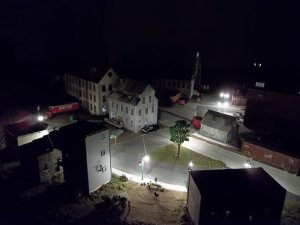Red Oak & Western
Active Member
Working on a project for one of my other hobbies, I dragged (drug?) out all my electronics experimenter supplies. (I'm building a Time Domain Reflectometer to get my ham station ready for winter.) That got me to thinking what I could build as accessories for the railroad.
I recently received a shipment of street lights I purchased on eBay, and I am really pleased with them.

So to make turning them on and off easier, and make the under layout wiring cleaner, I designed a driver circuit so that a single panel switch would be able to turn up to 10 lights on and off. The quantity 10 is just an arbitrary number based on how many drivers would fit onto a specific circuit board size. I tested the design and it does just what I wanted it to do – flip one switch and all the streetlights in one area come on. That was followed by – why not have the lights controlled by a photo sensor – it gets dark, and the lights come on automatically. So I designed and prototyped an electronic switch using a photoresistor. Dark = on, light = off. Everything is working so far.
Playing with it brought up the question: Do street lights come on gradually? It's be so long since we have lived in an area that has street lights, I don't remember. I vaguely remember the street light in front of my childhood home flickering blue as it came on, then it burst into bright white. But the town changed the type of bulb so that it was more of an orange, and I don't remember how it came on, only that it gave off weird looking light.
I'm inclined to give them a "soft start", that is, take about a second to transition from full off to full on.
Any ideas or comments?
I recently received a shipment of street lights I purchased on eBay, and I am really pleased with them.

So to make turning them on and off easier, and make the under layout wiring cleaner, I designed a driver circuit so that a single panel switch would be able to turn up to 10 lights on and off. The quantity 10 is just an arbitrary number based on how many drivers would fit onto a specific circuit board size. I tested the design and it does just what I wanted it to do – flip one switch and all the streetlights in one area come on. That was followed by – why not have the lights controlled by a photo sensor – it gets dark, and the lights come on automatically. So I designed and prototyped an electronic switch using a photoresistor. Dark = on, light = off. Everything is working so far.
Playing with it brought up the question: Do street lights come on gradually? It's be so long since we have lived in an area that has street lights, I don't remember. I vaguely remember the street light in front of my childhood home flickering blue as it came on, then it burst into bright white. But the town changed the type of bulb so that it was more of an orange, and I don't remember how it came on, only that it gave off weird looking light.
I'm inclined to give them a "soft start", that is, take about a second to transition from full off to full on.
Any ideas or comments?


